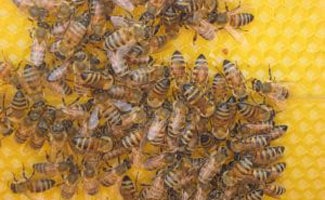Is The Honey Bee In Danger of Extinction?
 The Honey Bee is one of nature’s peculiarities but it is one creature which nature itself depends upon to a great extent. Without the Honey Bee, there are many species of plants and fruit bearing trees that would not be pollinated and should the day come where the Honey Bee is no longer available these plants and trees would surely die out. As of late there has been a concern of the disappearance of Honey Bees surrounded by the worry that these beautiful natural pollinators will soon die out completely and since 2006 researchers have been dedicated to finding out more about this mysterious Colony Collapse Disorder to see what can be done to prevent it and save not only the Honey Bee but also the trees and flowers which it pollinates.
The Honey Bee is one of nature’s peculiarities but it is one creature which nature itself depends upon to a great extent. Without the Honey Bee, there are many species of plants and fruit bearing trees that would not be pollinated and should the day come where the Honey Bee is no longer available these plants and trees would surely die out. As of late there has been a concern of the disappearance of Honey Bees surrounded by the worry that these beautiful natural pollinators will soon die out completely and since 2006 researchers have been dedicated to finding out more about this mysterious Colony Collapse Disorder to see what can be done to prevent it and save not only the Honey Bee but also the trees and flowers which it pollinates.
What Does the Honey Bee Do?
The Honey Bee is considered one of nature’s peculiarities due to the fact that judging from its size and the size of its wings it should not actually be capable of flight. However, the ingenious Honey Bee utilizes its body in such a way that it is able to maneuver not just efficiently but also very skillfully from flower to flower collecting pollen and in the process pollinating plants and trees as it goes. The body of the Honey Bee is not just a speedy flying machine but it also takes part in a wide variety of tasks that make the Honey Bee such an amazing insect.
Does the Honey Bee Die After One Sting?
Probably most well known about the Honey Bee is the presence of a stinger which contains venom that is so painful to many who experience a bee sting. The general public believes that the Honey Bee is only capable of one sting in its lifetime; however, this is not necessarily true. The Honey Bee’s stinger is attached to its abdomen and upon stinging and individual with particularly thick skin the barbed stinger can catch and rip out the abdomen of the bee which causes death. If the skin of the Honey Bee’s victim is not particularly thick though the stinger will not catch and the bee will not die. It is only the female Honey Bee that is capable of stinging as the males do not possess a stinger. The Honey Bee carries a natural warning of its ability to sting in its coloring. The bright yellow coloring of the Honey Bee serves to warn predators of the insect’s ability to inflict pain upon anyone attempting to feed upon it.
What do Honey Bees See?
Like most other insects the Honey Bee has compound eyes that are made up of many smaller eyes that receive images and compose a complete picture in the Honey Bee’s brain. Not all bees’ eyes are the same; however, as can be seen through comparison of the drones and the other bees in the hive. A bee’s society is comprised of a queen bee, drone bees and worker bees. The drone bees are male bees and they purposefully have larger eyes than the other bees in the hive so that they can spot queen bees on their nuptial flight.
Video: How Bees Hatch
Watch this incredible time-lapse video from National Geographic to see a bee forms from egg to flying out of the comb in just one minute.
Each Honey Bee Has its Own Purpose
Eyes are not the only different feature of each of the different types of bee within the hive. For each bee in the hive, there is a specific purpose. The queen bee of the hive is the only queen and her sole purpose within the hive is to reproduce and create more bees. The queen bee is much like the super bee of the hive; she lays more than one thousand eggs a day and is capable of reusing her stinger multiple times. The queen bee is also much larger than the other bees in the hive and generally lives longer than them, sometimes living as long as eight years! Sadly for the drone bees, their lifespan is only around eight weeks. These smaller male bees do not have stingers and their purpose in the hive is to mate with the queen to produce more bees. Within a hive, there will only be around two hundred drones present and at the end of each season, any drones which are not yet dead and are still living within the hive will be chased out by the other bees.
The Importance of the Worker Bees
Unlike the queen bee and the drone bees, the worker bees make up the majority of the hive. The worker bees serve the hive in every aspect that does not involve mating and reproduction. The worker bees are all female bees that are incapable of reproduction. Young worker bees are called house bees as they tend to the hive with duties that include cleaning house, defending the hive from attackers, tending to the queen and her drones and rearing younger bees. Once they mature the workers become known as field bees and they spend most of their life outside of the hive where they collect pollen, nectar, water and materials used by the bees to construct their beehive. Worker bee’s lifespan varies depending on when they were born in the season and can be as short as six weeks and as long as nine months. Worker bees are physiologically different from other bees in the hive in that they have a basket for collecting pollen on their hind legs as well as an extra stomach which is utilized for transporting and storing nectar. The worker bee is the bee that most often stings.
The Crucial Role of the Field Bees
When field bees are sent out to collect pollen they carry the pollen they collect in their pollen baskets on their knees. As the field bees fly from flower to flower collecting pollen they often wind up rubbing off traces of pollen onto neighboring flowers and this results in pollination of the flower or plant. Some plants would never pollinate if it wasn’t for the Honey Bee which is why it is so important that the Honey Bee remain a healthy species because without them the ecosystem would suffer a great impact. Studies show that nearly ¼ of the pollination required for fruit produced in the United States is accomplished by the Honey Bee so it is not only plant life that is reliant upon pollination by the Honey Bee but it is also the human diet! Once a bee has filled its pollen baskets they will return to their hive where they will remove the pollen from its legs and put it into a section of the bee hive where it serves as a food source for the bees within the hive.
Beehive Composition
| Editor’s Pick |
 Mann Lake 10-Frame Complete Painted Hive Kit Mann Lake 10-Frame Complete Painted Hive Kit |
The beehive itself is composed of honeycomb which is comprised of cells made from beeswax. Beeswax is a special substance that is produced only by the worker bees on their abdomens via special glands specific to the worker bee. Beeswax is formed by the bees mouths to make the honeycomb and once the cells are formed they are utilized as “rooms” within the hive which have a variety of uses including housing young bees and storing the pollen retrieved by the field bees. The cells of the honeycomb are also used to store the honey which is created by honeybees by refining and concentrating the nectar they retrieve from flowers. Bees feed on honey created from the nectar they collect year round; this ensures that the beehive will have a sustainable food resource through the colder weather when nectar is not accessible. Honey Bees feed on their honey throughout the winter and this serves to keep their body temperature raised enough to prevent them from freezing during the severe cold temperature that winter brings.
Africanized Honey Bee, aka the “Killer Bee”
One of the most publicized groups of Honey Bee is the Africanized Honey Bee which is also known as the killer bee. Africanized bees were engineered to produce honey more efficiently in hotter climates; however, an unfortunate side effect of these bees is that they also were extremely aggressive and oftentimes they end up stinging an individual to death when they disturb the Africanized bees nest. Africanized bees made their appearance in the United States after being accidentally released in Brazil by a scientific researcher. The bees took to the tropical conditions and began to reproduce and even travel up to the northern United States.
Are There Killer Bees in the U.S.?
Though attacks by Africanized bees within the United States are rare they are certainly not unheard of. While many people suggest running to water when being attacked by a hive of bees this does not work with Africanized Honey Bees as they tend to wait for you above the water. The most successful way to escape an angry hive of Africanized Honey Bees is to run away in a straight line making sure not to flail your arms or open your mouth. Run to an enclosed area such as inside the house or inside the car quickly and let as few bees inside as possible. If you are in your car and find yourself trapped with a few of the bees it is best to drive a short way before opening a window to let the remaining bees out. When pest control or the fire department is called to handle Africanized bees they generally drown the bees in thick foam.
What is Behind the Honey Bee Extinction?
Are bees going extinct? While Africanized Honey Bees are posing a threat to people it seems that humans have become something of a threat to the common Honey Bee. Colony Collapse Disorder has been making its round in the news for a few years now and speculates on the cause of the honey bee extinction. The reduction in population is not only concern for environmentalists but bees becoming extinct would have an impact on human life which is something that should be of concern to everyone. As to why are bees going extinct? No one is exactly sure of what causes Colony Collapse Disorder and the extinction of bees, but it is the name given to the dying off of considerable portions of the bee population. In 2007 beekeepers noticed that the die-off rate of their European Honey Bees were as high as 30 to 70% of the hive and many potential causes for this die-off have been speculated.
Variety of Theories
Some believe that bees are in danger of dying off due to impaired protein production by the bees as a result of infection with illnesses such as Israeli Acute Paralysis Virus. Others believe that there are more human engineered reasons for the decline in the Honey Bee population and cite things such as environmental toxins, pesticides, pollution of the airwaves and other unsubstantiated ideas to be to blame. Currently, the idea behind Colony Collapse Disorder that has the most substantiation is that of a disease or specific syndrome such as Israeli Acute Paralysis Virus causing mutation within the bee that interferes with the Honey Bee’s ability to produce protein.
While research continues into the reason behind the sudden drop off in bee populations that has been present since late in 2006, a definitive answer has yet to reveal why the Honey Bee populations are suffering. It is the hopes of researchers that a cause of Colony Collapse Disorder will soon be pinpointed so that they can begin working towards a cure or at least a preventative to protect current and future Honey Bee populations. Should the number of Honey Bees continue to decline as a result of Colony Collapse Disorder; however, the planet will not only suffer the loss of a beautiful creature but it will also suffer the repercussions of losing certain species of plants and fruits and the production of honey will be eliminated completely.
Our Planet Needs Honey Bees
For such an incredibly small creature to have such a large impact on the life of the planet seems absolutely amazing. It seems impractical for other life forms to depend upon something so minuscule and yet the Honey Bee serves to be one of nature’s hardest workers and most valuable players in the insect kingdom. Of all the species that the world has lost or that mankind has eliminated from the face of the earth the Honey Bee is one which will have such a butterfly effect upon life on the planet Earth as we know it. Loss of the Honey Bee will eventually lead to the eradication of a large portion of plant life thereby affecting the crop levels and food production and therefore the entire human race. This tiny little miracle of mother nature is not just a cute and fuzzy insect or to some an anaphylactic shock waiting to happen, the Honey Bee is the pollinator of the majority of our food crops and a creature that, like it or not, we depend on heavily to harvest our large crops at the end of each year.
What’s your take on bees: buzz off or bring ’em on?



